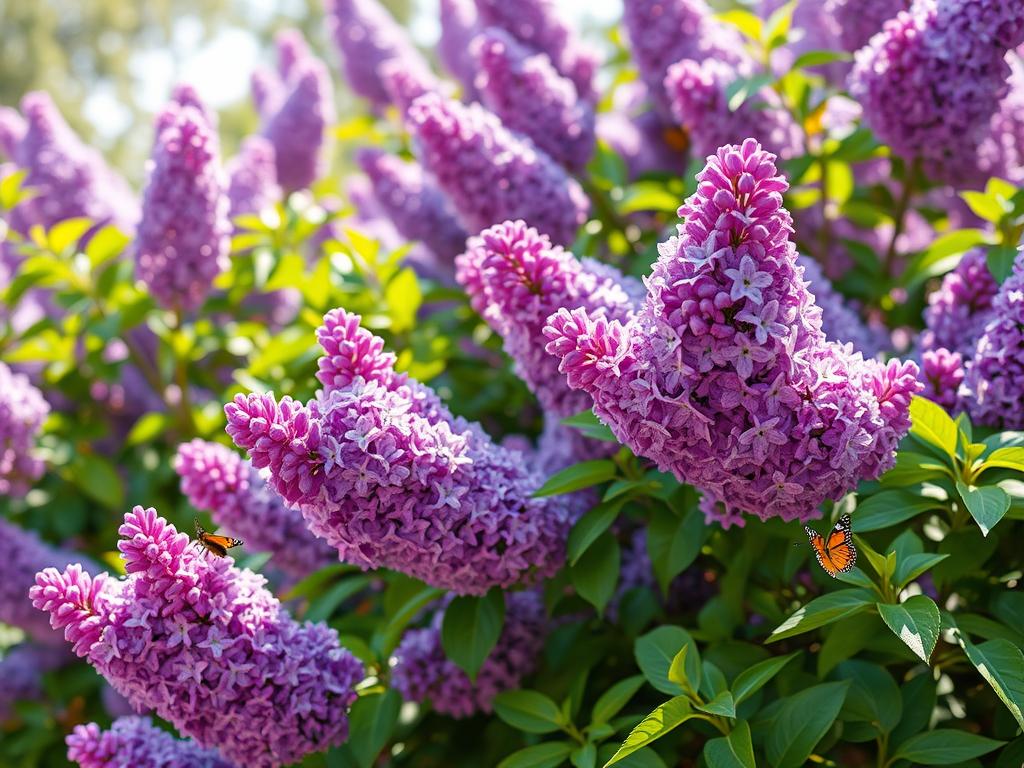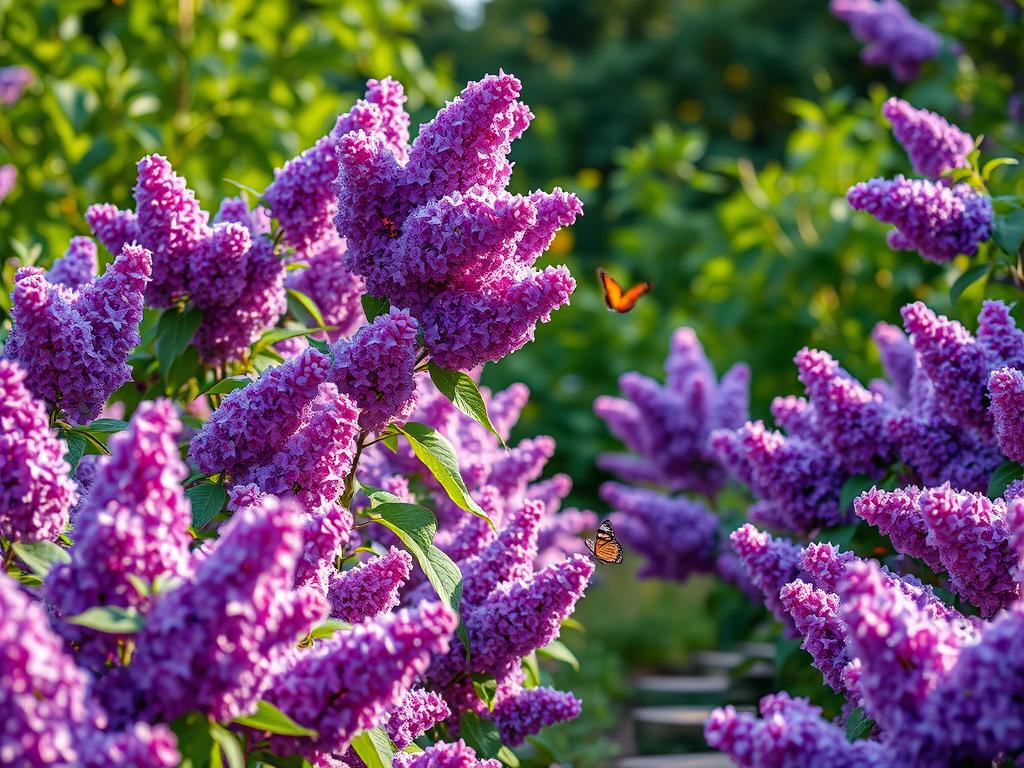The lilac bush is a true sign of spring, filling gardens with its beautiful purple flowers and sweet scent. These shrubs are a favorite in many gardens, adding elegance and charm. We’ll share tips on how to grow and care for lilacs, helping you create a lovely lilac garden.
Key Takeaways
- Lilac bushes are low-maintenance, perennial plants that thrive in a wide range of growing conditions.
- Proper planting, soil preparation, and pruning techniques are essential for healthy, vibrant lilac blooms.
- Lilacs come in a variety of colors, including purple, white, pink, and even yellow, allowing you to create a personalized floral display.
- Lilac bushes are versatile landscaping plants, suitable for borders, hedges, and as standalone specimen plants.
- These fragrant beauties are a magnet for pollinators, contributing to a thriving, biodiverse garden.
The Allure of Lilac Bushes
When spring’s warm days come, lilac bushes show off their beautiful blooms. These shrubs are loved for their sweet smell and lovely spring flowers. They make any garden look brighter and more elegant.
Exploring the Enchanting Fragrance and Beauty
Lilac bushes are famous for their strong, sweet smell. This scent fills the air when they bloom. The smell of lilacs is a treat for anyone who loves flowers. They also have beautiful spring flowers in many colors, like deep purple, white, pink, and yellow.
Varieties and Colors to Brighten Your Garden
- Classic Purple Lilacs: The quintessential lilac bush, with lush clusters of fragrant purple flowers.
- White Lilacs: Offering a more subtle, elegant appearance with pure white blossoms.
- Pink Lilacs: Adding a softer, romantic touch with their delicate pink hues.
- Yellow Lilacs: A rarer and more unique variety, bringing a warm, sunny pop of color to the garden.
Choosing any lilac bush will make your garden more beautiful. These flowering bushes are known for their lovely smell and look. They make any outdoor area more special.
Planting Lilac Bushes for Maximum Growth
Proper planting techniques are key for growing vibrant lilac bushes. These hardy perennials need the right site and soil to thrive. Follow these expert tips to give your lilacs a strong start and lots of blooms every year.
Choosing the Right Planting Site
Lilacs love sunlight, so pick a spot that gets at least six hours of direct sun daily. Make sure the area is well-drained and safe from strong winds. Don’t plant them too close to big shrubs or trees, as their roots might compete for water and nutrients.
Preparing the Soil
Lilacs do well in slightly acidic, well-drained soil full of organic matter. Before planting, mix in compost or other woody plants. This boosts drainage and gives your lilacs the nutrients they need to grow strong.
Planting Techniques
- Dig a hole that is twice the width of the root ball and just as deep.
- Place the lilac bush in the hole, ensuring the top of the root ball is level with the surrounding soil.
- Backfill the hole with the amended soil, gently tamping it down to remove any air pockets.
- Water the newly planted lilac thoroughly to help it establish its root system.
By using these best practices for planting lilac bushes, you’ll help them grow healthy and bloom abundantly in your garden.
“Lilacs are the quintessential spring-blooming ornamental bushes, filling the air with their captivating fragrance and adding a touch of elegance to any garden design.”
Optimal Soil Conditions for Thriving Lilacs
To grow vibrant and healthy lilac bushes, start with the right soil. These landscaping plants do best in well-drained, slightly acidic soil. The ideal pH level is between 6.0 and 7.0. It’s important to know what nutrients they need for great growth and blooms in your garden design.
Understanding pH Levels and Nutrient Requirements
Lilac bushes like slightly acidic soil, which helps their roots get the nutrients they need. You can check your soil’s pH with a test kit or get advice from a landscape shrubs expert. If your soil is too alkaline, add sulfur or peat moss to lower the pH.
- Lilacs do well in soil full of nitrogen, phosphorus, and potassium, which are key for growth.
- Adding compost or well-aged manure to the soil gives these woody ornamentals the nutrients they need.
- Don’t over-fertilize, as too much nitrogen can make the plants focus on leaves instead of flowers.
By keeping the soil’s pH and nutrients balanced, you create the best spot for your backyard landscaping lilac bushes. This way, they’ll grow well and give you beautiful blooms and a lovely scent.
Lilac Bushes: Sunlight and Water Needs
Lilac bushes are a favorite in many gardens. They need the right amount of sunlight and water to grow well. Knowing what they need helps them bloom and grow season after season.
Lilacs love the sun and do best in full sun. They need at least six hours of sunlight each day. Eight to ten hours is even better. Make sure they’re in a spot that gets plenty of sunlight all day.
Lilacs need regular watering but not too much. They like soil that’s moist but drains well. During the growing season, water them often to keep the soil moist. But, you can water less as the weather gets hotter and they get bigger.
| Sunlight Needs | Water Needs |
|---|---|
| 6-10 hours of direct sunlight per day | Consistently moist, well-drained soil |
| Full sun exposure | Moderate water needs |
Give your lilac bushes the right sunlight and water, and they’ll thrive. They’ll give you beautiful smells and colors every year. Adding these tips to your garden makes it look lush and shows off the beauty of lilacs.
Pruning Techniques for Healthy Lilac Bushes
Keeping your lilac bushes healthy is key to enjoying their lovely scent and bright flowers every year. Using the right pruning methods is important. It helps you shape and care for your landscaping plants well.
When and How to Prune for Optimal Blooms
The best time to prune lilac bushes is in late spring, right after the flowers fade. This way, you won’t cut off the buds for next year’s flowers, which grow in summer. When you prune, take out dead, damaged, or crossing branches and suckers from the base.
- Use sharp, clean pruning shears or loppers to make clean, angled cuts just above an outward-facing bud or branch.
- Avoid cutting the main trunks or stems by more than one-third of their height, as this can weaken the plant and reduce the number of perennial plants.
- Thin out the interior of the bush to improve air circulation and light penetration, which can help prevent disease and encourage the formation of more garden design blooms.
By following these pruning tips, your lilac bushes will stay healthy, full of life, and full of fragrant flowers. This will make your backyard landscaping even more beautiful.
Pest and Disease Control for Vibrant Lilacs
To keep lilac bushes looking great, you need to watch out for pests and diseases. Aphids and powdery mildew can harm your landscaping plants. But don’t worry, there are ways to keep your perennial plants safe and your garden design looking good.
Identifying and Addressing Common Lilac Pests
Aphids are a big problem for lilac bushes. These tiny bugs drink the sap, making the plants weak and slow to grow. To fight aphids, you can use ladybugs or a gentle soap spray. Leaf miners also bother lilac bushes, but cutting off the damaged leaves can stop them.
Combating Lilac Diseases
Powdery mildew often hits lilac bushes, covering them in a white powder. Good air flow, trimming, and organic fungicides can beat this. Lilac blight, a bacterial disease, is another issue. Cut out sick parts and use copper-based sprays to fight it.
By watching closely and using safe pest and disease control, you can keep your lilac bushes healthy and beautiful. With some care, these lovely landscape shrubs will make your backyard landscaping look great.

Incorporating Lilac Bushes into Landscape Design
Lilac bushes are great for adding beauty and fragrance to any garden. They are versatile and can make your outdoor spaces look better. These plants are perfect for boosting your garden’s curb appeal and style.
Creative Ideas for Stunning Curb Appeal
Using lilac bushes as focal points is a great idea. Plant them along your front entryway or in your backyard. This makes your property look welcoming and raises its overall appeal.
Lilac bushes also look good with other plants in mixed borders. Try them with flowers, shrubs, and grasses for a beautiful look. Mixing colors and textures can make your garden stand out.
| Landscape Feature | Lilac Bush Placement |
|---|---|
| Front Entryway | Focal point |
| Mixed Border Plantings | Integrated with other shrubs and perennials |
| Garden Pathways | Lining the edges or as accents |
| Backyard Seating Areas | Surrounding the space for fragrance and ambiance |
Adding lilac bushes to your landscape can make your outdoor areas look amazing. Whether you want a beautiful entryway, a stunning border, or a peaceful backyard, lilac bushes are a great choice. They will leave a lasting impression on everyone who sees your garden.
Lilac Bushes: Low-Maintenance Gardening Delight
Lilac bushes are perfect for anyone who wants a beautiful garden with little work. They turn any backyard into a place filled with lovely smells. These shrubs are tough and don’t need much care, making them great for busy people or gardening beginners.
Lilac bushes are easy to care for. They don’t need much pruning and can grow well in many types of soil. This makes them perfect for gardens that are easy to keep up. Their flowers last a long time and grow strong, so you can enjoy their beauty every year with hardly any work.
Lilac bushes fit well in many garden styles. They can add a classic look or be the main attraction in your garden. With their bright colors and sweet smell, they are a joy to have in any garden. They need very little care to stay beautiful.
“Lilac bushes are the perfect low-maintenance addition to any garden, offering an unparalleled combination of beauty and ease of care.”
If you want a garden that looks great with little effort, think about adding lilac bushes. These shrubs are easy to grow and will give you beautiful flowers every year. Just prune them a bit and give them some love, and they’ll be happy.

Propagating Lilacs: Sharing the Beauty
Lilac bushes bring joy with their sweet scent and bright colors. They can make any garden look better. Propagating these shrubs lets you share their beauty with others. It’s a great way to grow more lilacs for your garden or give them as gifts to family and friends.
One easy way to spread lilacs is by taking cuttings. Choose healthy stems and root them in the right conditions. You can also divide lilac bushes to make more plants. This method ensures each new plant has strong roots for growth.
When propagating lilacs, remember to consider their soil and sunlight needs. With proper care, you’ll see new plants grow and bloom. These new lilacs can be part of your garden or gifts for those you care about.

